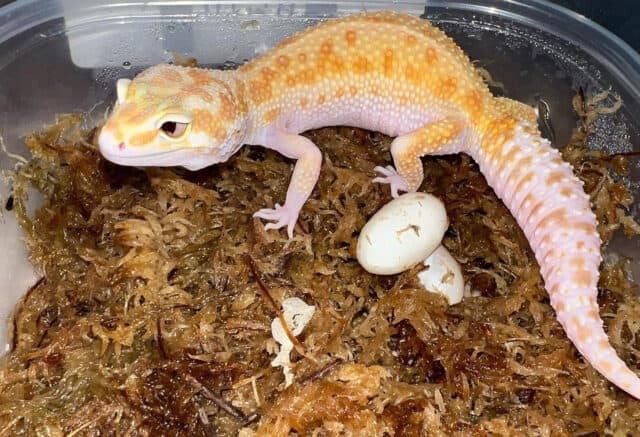Absolutely, a female gecko can lay eggs even if she hasn’t mated. This phenomenon is known as parthenogenesis. Essentially, parthenogenesis is a reproductive process where an egg develops into an individual without being fertilized.
For leopard geckos, while it’s less common, it’s not unheard of. However, it’s crucial to understand that these eggs are infertile. This means they won’t hatch into baby geckos.
Parthenogenesis: This is a reproductive process where female geckos can lay eggs without mating. However, these eggs are typically infertile and won’t hatch into baby geckos.
Signs Before Laying Eggs: Female Leopard Geckos exhibit clear signs such as excessive digging, muscle contractions in the hind limbs, and visible eggs on their underside.
Disposal of Infertile Eggs: If you discover infertile leopard gecko eggs, consider giving them to another breeder, using them as feeder eggs, adding them to a compost pile, or keeping them as souvenirs.
Verify Infertility: Always verify the infertility of the eggs before any disposal to avoid unintentionally discarding viable eggs.
Can a Female Gecko Lay Eggs Without Mating?

Certainly, a female gecko has the ability to lay eggs, even in the absence of mating. This intriguing reproductive method is known as parthenogenesis.
Parthenogenesis is a complex process where an egg evolves into an organism without undergoing fertilization. In the world of reptiles, this method isn’t ubiquitous but has been observed in various species, including some geckos.
In the context of Leopard Geckos, laying infertile eggs is a possibility. It’s essential to note that these eggs, while formed, are infertile. This indicates that they lack the potential to hatch into new geckos.
Several factors can trigger the laying of infertile eggs. One primary consideration is the gecko’s first mating experience. A fascinating aspect of gecko biology is their ability to retain sperm from a single mating session, utilizing it across multiple breeding cycles. Despite this ability, there are instances where a female, post-mating, will produce infertile eggs.
Another contributing element can be health concerns. A gecko’s well-being directly impacts its reproductive system. If she’s not in optimal health (carrying salmonella or many other diseases), the chances of laying infertile eggs increase.
Signs That a Female Leopard Gecko Is About To Lay Eggs
When a female Leopard Gecko is on the verge of laying eggs, she displays several distinct behaviors and physical signs. Recognizing these signals can help breeders and pet owners anticipate the laying process and provide the necessary care.
One of the most noticeable signs is excessive digging. The gecko might start to dig more frequently in her enclosure, specifically in moist and cooler areas. This behavior is a natural instinct, as she’s trying to find the perfect spot to lay her eggs.
Following the digging, you might observe muscle contractions in the gecko’s hind limbs. These contractions, often subtle, are an indication that she’s preparing her body for the egg-laying process.
Another unmistakable sign is the presence of visible eggs on the underside of the gecko’s body. As the eggs mature and get ready for laying, they can sometimes be seen through the thin skin of the gecko’s abdomen, appearing as whitish ovals.
Additionally, a drop in her food intake or a loss of appetite can be a clear indication that she’s about to lay eggs. It’s not uncommon for female geckos to eat less during this period.
Lastly, a clear fluid leaking from the cloaca, the common chamber into which the intestinal, urinary, and reproductive tracts open, can be observed. This fluid acts as a lubricant, facilitating the smooth passage of the eggs.
What To Do With Infertile Eggs?
Dealing with infertile leopard gecko eggs can be a conundrum for many breeders and gecko enthusiasts. While these eggs won’t produce any offspring, there are several ways to handle them responsibly and ethically.
One option is to offer them to another breeder. Some breeders might be interested in studying infertile eggs, either for research purposes or to train new breeders in recognizing and handling them. It’s a good practice to reach out to local reptile communities or online forums where you can connect with interested parties.
Another practical use for these eggs is as feeder eggs. Some reptiles and amphibians can benefit from the nutritional value of these eggs. However, before using them as a food source, ensure they are suitable and safe for consumption by the intended species.
For those inclined towards eco-friendly solutions, adding the eggs to a compost pile is an excellent choice. Rich in calcium and other minerals, these eggs can decompose and enrich the compost, which can later be used to nourish plants.
If you’re sentimentally attached or find the eggs intriguing, consider preserving them as souvenirs. With the right preservation techniques, they can be kept for a long time, serving as a reminder of your gecko breeding experience.
However, a crucial step before deciding on any of the above methods is to confirm the eggs are genuinely infertile. Mistakes can happen, and the last thing anyone would want is to dispose of eggs that had the potential to hatch.
Observing the eggs under a light, a process called “candling,” can help determine their status.